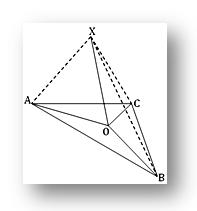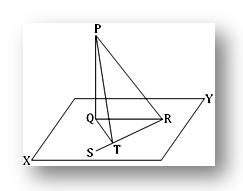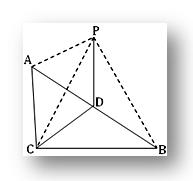Subscribe to our ▶️ YouTube channel 🔴 for the latest videos, updates, and tips.
Theorems on Straight Lines and Plane
Here we will discuss about the theorems on straight lines and plane using step-by-step explanation on how to proof the theorem.
Theorem: If a straight line is perpendicular to each of two intersecting straight lines at their point of intersection, it is also perpendicular to the plane in which they lie.
Let the straight line OP be perpendicular to each of two intersecting straight lines OM and ON at their point of intersection O and XY be the plane in which OM and ON lie. We are to prove that the straight line OP is perpendicular to the plane XY.
Construction: Through O draw any straight line OC in the XY plane and take any point C on it. Now, complete the parallelogram OACB in the XY plane by drawing lines CB and CA parallel to OM and ON respectively. Join AB, which cuts OC at D. Join PA, PB and PD.
Proof: Since OACB is a parallelogram and its two diagonals AB and OC intersect at D, hence D is the mid-point of AB (Since, diagonals of a parallelogram bisect each other).
Therefore, PD is a median of the triangle APB; hence, by Apollonius theorem we get,
AP² + BP² = 2 (AD² + PD²) . . . (1)
Again, OC is a median of the triangle OAB; hence, by the same theorem we get,
OA² + OB² = 2 (AD² + OD²) . . . (2)
Subtracting (2) from (1) we get,
(AP² - OA² ) + (BP² - OB² ) = 2 (PD² - OD² ) . . . (3)
Now, OP is perpendicular to both OA and OB.
Therefore, AP² = OA² + OP²
or, AP² – OA² = OP² . . . (4)
and BP² = OB² + OP ²
or, BP ² - OB² = OP² . . . (5)
From (3), (4) and (5) we get,
OP² + OP² = 2 (PD² - OD²)
or, 2. OP ² = 2 (PD² - OD²)
or, OP ² = PD² - OD²
or, OP ² + OD² = PD²
Therefore, ∠POD (i.e., ∠POC) is a right angle.
Therefore, OP is perpendicular to OC at O. But OC is any straight line through O in the plane XY. Therefore, OP is perpendicular to the plane XY at O.
Examples:
1. O is a point in the plane of the triangle ABC; if X be a point outside the plane such that PO is perpendicular to both OA and OB and if XA = XB = XC, show that O is the circum-centre of the triangle ABC.
Since XO is perpendicular to both OA and OB at their point of intersection O, hence, XO is perpendicular to the plane of the triangle ABC. Therefore, XO is perpendicular to OC.
Now, in triangles XOA and POB we have
XA = XB (given), XO is common and ∠XOA = ∠XOB (each being a right angle)
Therefore, triangles XOA and XOB are congruent.
Therefore, OA = OB . . . (1)
Similarly, in triangles XOA and XOC we have,
XA = XC (given), XO is common and ∠XOA = ∠XOC = 1 rt. angle.
Therefore, triangles POA and POC are congruent
Therefore, OA = OC . . . (2)
From (1) and (2) we get, OA = OB = OC
Therefore, O is the circum-centre of the triangle ABC.
2. The straight line PQ is perpendicular to a plane ; in this plane the straight line QT is perpendicular to a straight line RS at T. Show that RT is perpendicular to the plane containing PT and QT.
Let PQ be perpendicular to the plane XY at Q. In XY plane, draw QT perpendicular to a straight line RQ, T being the foot of the perpendicular. Join PR, QR and PT.
It is required to prove that RT is perpendicular to the plane containing PT and QT.
Since PQ is perpendicular to the plane XY and the lines QR and QT lie in this plane, hence PQ is perpendicular to both QR and QT. Therefore, from the right-angled △ PQR we get,
PQ² + QR² = PR²
or, PQ² = PR² - QR² . . . (1)
Again, from the right-angled △ PQT we get,
QT² = PQ² + QT² = PR² – QR² + QT² [using (1)]
= PR² - (QR² - QT²)
= PR² - RT²
[Since, QT ⊥ RT Therefore QR² = QT² + RT² or, QR² – QT² = RT²]
Or, TR ² = QT ² + RT²
Therefore, PT ⊥ RT i.e., RT is perpendicular to PT.
Again, RT is perpendicular to QT (given). Thus, RT is perpendicular to both PT and QT.
Therefore, RT is perpendicular to the place containing PT and QT.
3. ABC is a triangle right – angled at C.P is a point outside the plane ABC such that PA = PB = PC. If D be the mid-point of AB, prove that PD is perpendicular to CD. Show also that PD is perpendicular to the plane of the triangle ABC.
By question ACB = 1 rt and D is the mid-point of the hypotenuse AB in ABC.
Therefore, AD = BD = CD.
Now, in triangle PDA and PDB we have
PA = PB (given), AD = BD and PD is common. Therefore, the triangle is congruent.
Therefore PDA = PDB = ½ ∙ 2 rt. Angles
= 1 rt. Angle.
i.e., PD is perpendicular to DA
Again, in triangle PDA and PDC we have,
PA = PC (given), AD = DC and PD is common.
Therefore, the triangles are congruent.
Therefore, PDC = PDA = 1 rt. Angle.
i.e., PD is perpendicular to DC.
Therefore, PD is perpendicular to both DA and CD i.e., PD is perpendicular to the plane containing DA and DC i.e., it is perpendicular to the plane of the triangle ABC.
● Geometry
- Solid Geometry
- Worksheet on Solid Geometry
- Theorems on Solid Geometry
- Theorems on Straight Lines and Plane
- Theorem on Co-planar
- Theorem on Parallel Lines and Plane
- Theorem of Three Perpendiculars
- Worksheet on Theorems of Solid Geometry
11 and 12 Grade Math
From Theorems on Straight Lines and Plane to HOME PAGE
Didn't find what you were looking for? Or want to know more information about Math Only Math. Use this Google Search to find what you need.






New! Comments
Have your say about what you just read! Leave me a comment in the box below. Ask a Question or Answer a Question.